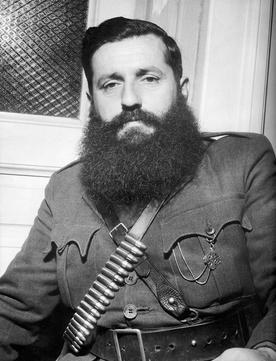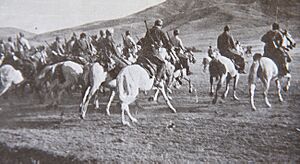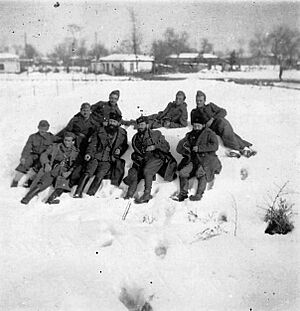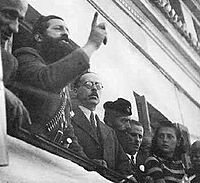Aris Velouchiotis facts for kids
Quick facts for kids
Aris Velouchiotis
|
|
|---|---|

Velouchiotis in Athens after the Liberation (Hotel Grand Bretagne, photo by Dmitri Kessel)
|
|
| Born |
Athanasios Klaras
August 27, 1905 Lamia, Greece
|
| Died | June 15, 1945 (aged 39) |
| Nationality | Greek |
| Organization | National Liberation Front Greek People's Liberation Army |
| Political party | Communist Party of Greece |
Athanasios Klaras (Greek: Αθανάσιος Κλάρας; August 27, 1905 – June 15, 1945), known as Aris Velouchiotis (Greek: Άρης Βελουχιώτης), was an important Greek leader. He was a journalist and a member of the Communist Party of Greece. He became the main leader of the Greek People's Liberation Army (ELAS). This group was the military part of the National Liberation Front (EAM). EAM was the biggest resistance group in Greece during World War II, from 1942 to 1945.
Contents
Early Life
Athanasios Klaras was born in Lamia, Greece, in 1905. His family was well-known and his father was a lawyer. Athanasios first studied journalism. Later, he graduated from the Geoponic School of Larissa. He then moved to Athens.
In Athens, he worked different jobs. He joined movements that supported leftist ideas and were against war. He became a member of the Communist Party of Greece (KKE). During the 1920s and 1930s, he was put in jail several times.
He worked as an editor for the communist newspaper Rizospastis. He wrote articles supporting a socialist revolution. In 1931, one of his articles caused problems. The authorities closed the newspaper and went after its editors. The newspaper later reopened under a new name.
During the Metaxas regime (1936–1941), communists in Greece faced a very hard time. Velouchiotis was arrested in late 1936 for his communist beliefs. He was jailed in Aegina and faced harsh questioning. He tried to escape in 1937 but was caught again. He stayed in prison until he signed a paper saying he no longer supported the Communist Party. This was a very difficult thing for a communist to do. These papers were often shared in people's home villages. This made some people see him as someone who had given up his beliefs.
World War II: From Klaras to Aris
During World War II, Athanasios Klaras fought as a soldier in the Greek Army. He fought against the Italian army in the Albanian front. This continued until the German invasion in April 1941. After the invasion, Greece was occupied by Axis forces.
When Germany attacked the Soviet Union, the Greek Communist Party decided to create the National Liberation Front (EAM). Klaras was sent to Central Greece. His job was to see if a guerrilla movement could be started there. His ideas were accepted by the party. In January 1942, Klaras went to the mountains to form guerrilla groups.
The first time the partisans Klaras organized appeared was on June 7, 1942. This happened in the village of Domnista in Evrytania. There, he introduced himself as an Artillery Major. He used the new name Aris Velouchiotis. Aris comes from Ares, the Greek god of war. Velouchi is a local mountain. He announced the creation of the Greek People's Liberation Army (ELAS). He started with only 15 men. Velouchiotis was a strict leader. ELAS grew to have up to 50,000 fighters.
One important early operation of the Greek resistance was the blowing up of the Gorgopotamos railway bridge. This happened on November 25, 1942. Velouchiotis and his fighters worked with other Greek resistance groups. They also worked with British soldiers. This operation cut the main railway line connecting the Balkans with southern Greece.
After this, the communist-influenced ELAS mostly fought on its own. There were disagreements between EAM and other resistance groups. EAM-ELAS was the strongest group in Greece. Other groups, and the British, worried that EAM would try to take control after the Germans left. These disagreements led to fighting among the Greek resistance groups in late 1943 and early 1944.
Liberation and Expulsion from Communist Party
In October 1944, the Nazis left Greece. ELAS was the main power in most Greek cities, except Athens. EAM had even set up its own government.
Velouchiotis went to Peloponnese to fight against groups that had cooperated with the Axis forces.
British forces and units of the Greek Army arrived in Greece. A new government was formed. Velouchiotis returned to Central Greece. He gave a speech in his hometown, Lamia.
During the Dekemvriana events in Athens, there was fighting between different Greek groups. Velouchiotis was sent to Epirus. He attacked the forces of another resistance leader, Zervas.
Later, the Varkiza Agreement was signed. This agreement aimed to stop the fighting between EAM forces and the government. Velouchiotis signed the agreement to disarm the ELAS army. However, he strongly disagreed with it afterwards. He felt it was a betrayal of the resistance fighters.
Because of this, the leaders of the Communist Party accused him of not being loyal. They removed him from the party. The Communist Party had always been a bit unsure about Velouchiotis. This was partly because he had signed the paper renouncing the party years before.
Death
Velouchiotis went back to the mountains of Central Greece. He wanted to start a new resistance against the new government and its British allies. He was very upset about the Varkiza Agreement. He felt it made the resistance fighters give up their weapons unfairly. He wanted to create a new ELAS army.
Most of his friends left him. He continued to lead guerrilla activities until June 1945. The Communist Party leaders had disowned him. He became more and more alone. He was then surrounded by government-controlled groups in the mountains of Agrafa. Aris and his second-in-command died together. This happened on the same day he learned he was no longer part of the communist party.
After the Greek government later recognized the EAM/ELAS and the Communist Party, statues of Aris Velouchiotis were put up in his hometown. The Communist Party also quietly recognized Velouchiotis again.
Legacy
Velouchiotis is a very discussed person in modern Greek history. People have many different ideas about him. His supporters see him as a symbol of Greek resistance against the occupying forces. They remember him as the founder of the biggest guerrilla army in Greek history, ELAS. They see him as a hero for the communist cause. Others remember him differently. They point to his strict actions against Greeks who were seen as opponents. He was known for being very tough on those who worked with the occupying forces. He was also strict with his own fighters if they broke rules. He strongly believed that the British should not be involved in Greek politics.
See Also
 In Spanish: Aris Velujiotis para niños
In Spanish: Aris Velujiotis para niños
- Georgios Grivas
- Salvatore Giuliano
- Che Guevara
- Emiliano Zapata
- Georgios Karaiskakis




